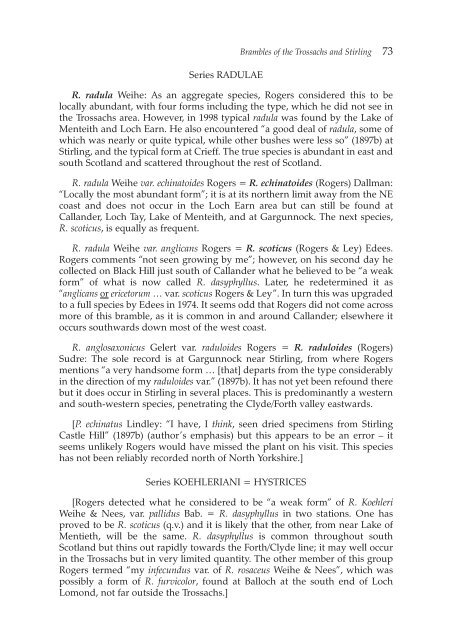the Forth Naturalist Historian - Forth Naturalist and Historian ...
the Forth Naturalist Historian - Forth Naturalist and Historian ...
the Forth Naturalist Historian - Forth Naturalist and Historian ...
Create successful ePaper yourself
Turn your PDF publications into a flip-book with our unique Google optimized e-Paper software.
Series RADULAE<br />
R. radula Weihe: As an aggregate species, Rogers considered this to be<br />
locally abundant, with four forms including <strong>the</strong> type, which he did not see in<br />
<strong>the</strong> Trossachs area. However, in 1998 typical radula was found by <strong>the</strong> Lake of<br />
Menteith <strong>and</strong> Loch Earn. He also encountered “a good deal of radula, some of<br />
which was nearly or quite typical, while o<strong>the</strong>r bushes were less so” (1897b) at<br />
Stirling, <strong>and</strong> <strong>the</strong> typical form at Crieff. The true species is abundant in east <strong>and</strong><br />
south Scotl<strong>and</strong> <strong>and</strong> scattered throughout <strong>the</strong> rest of Scotl<strong>and</strong>.<br />
R. radula Weihe var. echinatoides Rogers = R. echinatoides (Rogers) Dallman:<br />
“Locally <strong>the</strong> most abundant form”; it is at its nor<strong>the</strong>rn limit away from <strong>the</strong> NE<br />
coast <strong>and</strong> does not occur in <strong>the</strong> Loch Earn area but can still be found at<br />
Call<strong>and</strong>er, Loch Tay, Lake of Menteith, <strong>and</strong> at Gargunnock. The next species,<br />
R. scoticus, is equally as frequent.<br />
R. radula Weihe var. anglicans Rogers = R. scoticus (Rogers & Ley) Edees.<br />
Rogers comments “not seen growing by me”; however, on his second day he<br />
collected on Black Hill just south of Call<strong>and</strong>er what he believed to be “a weak<br />
form” of what is now called R. dasyphyllus. Later, he redetermined it as<br />
“anglicans or ericetorum … var. scoticus Rogers & Ley”. In turn this was upgraded<br />
to a full species by Edees in 1974. It seems odd that Rogers did not come across<br />
more of this bramble, as it is common in <strong>and</strong> around Call<strong>and</strong>er; elsewhere it<br />
occurs southwards down most of <strong>the</strong> west coast.<br />
R. anglosaxonicus Gelert var. raduloides Rogers = R. raduloides (Rogers)<br />
Sudre: The sole record is at Gargunnock near Stirling, from where Rogers<br />
mentions “a very h<strong>and</strong>some form … [that] departs from <strong>the</strong> type considerably<br />
in <strong>the</strong> direction of my raduloides var.” (1897b). It has not yet been refound <strong>the</strong>re<br />
but it does occur in Stirling in several places. This is predominantly a western<br />
<strong>and</strong> south-western species, penetrating <strong>the</strong> Clyde/<strong>Forth</strong> valley eastwards.<br />
[P. echinatus Lindley: “I have, I think, seen dried specimens from Stirling<br />
Castle Hill” (1897b) (author’s emphasis) but this appears to be an error – it<br />
seems unlikely Rogers would have missed <strong>the</strong> plant on his visit. This species<br />
has not been reliably recorded north of North Yorkshire.]<br />
Series KOEHLERIANI = HYSTRICES<br />
Brambles of <strong>the</strong> Trossachs <strong>and</strong> Stirling 73<br />
[Rogers detected what he considered to be “a weak form” of R. Koehleri<br />
Weihe & Nees, var. pallidus Bab. = R. dasyphyllus in two stations. One has<br />
proved to be R. scoticus (q.v.) <strong>and</strong> it is likely that <strong>the</strong> o<strong>the</strong>r, from near Lake of<br />
Mentieth, will be <strong>the</strong> same. R. dasyphyllus is common throughout south<br />
Scotl<strong>and</strong> but thins out rapidly towards <strong>the</strong> <strong>Forth</strong>/Clyde line; it may well occur<br />
in <strong>the</strong> Trossachs but in very limited quantity. The o<strong>the</strong>r member of this group<br />
Rogers termed “my infecundus var. of R. rosaceus Weihe & Nees”, which was<br />
possibly a form of R. furvicolor, found at Balloch at <strong>the</strong> south end of Loch<br />
Lomond, not far outside <strong>the</strong> Trossachs.]



